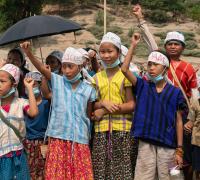Nagaland fieldwork
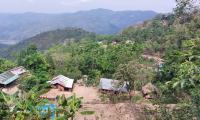
Read this blog in Burmese (pdf)
I am a Myanmar-born ethnic Naga who recently arrived in Kohima, Nagaland, India, to work on the Myclimate Project, jointly implemented by The Highland Institute (THI) and the Danish Institute for International Studies (DIIS). As a Naga, this is my first time visiting Nagaland on the Indian side, so my knowledge of the area is limited. During the initial stage of selecting villages for the Myclimate project, a board member of THI suggested studying three or four villages near the Myanmar border. One of the villages proposed was Machi village (pseudonym), home to the Pochury Naga tribe. The board member also mentioned that the village has a history and produces salt. Since then, I have always wanted to visit Machi village. The board member assured me that he could introduce me to some of the locals. However, despite my willingness to take risks and explore an unfamiliar place where an unfamiliar language is spoken, I also felt apprehensive. The Myclimate Project lead also expressed the importance of visiting the study villages before the rainy season, as many Naga villages are prone to landslides during that time, making travel difficult, especially in remote areas. Therefore, the trip was organized earlier than planned to avoid the monsoon. I requested a professor from THI to introduce me to local people, and he kindly connected me with a professor from Pfutsero who then introduced me to a person who held a position equivalent to Head Gaon Bura (HeadGB), which means like a village headman or village elder.
On June 5, I embarked on the journey to Machi village with Joseph, a driver who also served as a translator. Throughout the journey, I worried about how things would unfold, but upon arriving at Machi village, I didn't even realize that more than 6 hours had passed since leaving Kohima. Joseph mentioned that in the past, it took around 7 to 8 hours to reach the village due to poor roads.
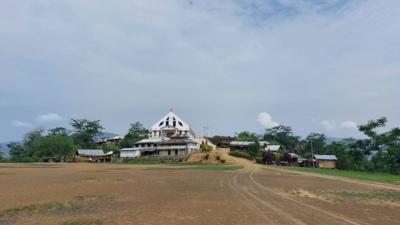
Finally, we reached the village. Most of the households in the village are located on a small hill, and houses that appear to be outbuildings are located along the hillside. From a visual perspective, the economy seems to be difficult without a large house, but the church located at the entrance of the village is very grand compared to the situation of the village. The weather was pleasant upon my arrival, with the sounds of birds, pets, and animals filling the air. It reminded me of my hometown. Looking towards Myanmar, I felt a sense of sadness for my parents and siblings in the village, but also a heartwarming realization that the people in this village were just like me. While the researcher was deep in thought, Joseph spoke to the Head GB on the phone and then drove us to his house. Head GB arranged for the researchers to stay at his house. Researchers are also warmly welcomed. When head GB learned that I was a Naga born in Myanmar, they said, "We are no different from you. We are brothers and sisters," and insisted that I address the Head GB as "brother." Additionally, he expressed gratitude for ou visit to the village. It was difficult to engage with the locals during the day as they were busy working on the farm, but the Head GB assured me that arrangements would be made for us to meet in the evenings and mornings. The warm welcome from the GB alleviated all my concerns and worries about the trip. I would like to extend my special thanks to everyone who helped make this trip possible, especially the Head GB and all the respondents.
Surviving tragedy: a Small Village named Machi
With the help of Head GB, we arrived at the home of 69-year-old Rev. Zhiwhuotho, a knowledgeable elderly person. Rev's house is a single-story dwelling. Upon entering the house, one passes through a kitchen adorned with an array of new cookware. Just a step away from the stove, there is a living room with a low wooden bedstead. Hanging on the wall of the living room is a picture of a Naga man, seemingly taken many years ago, wrapped only in a traditional Naga blanket. The house follows a hall-type style, comprising only a living room and a kitchen, without any additional rooms, and it appears to be neat and tidy.
Rev seemed to know we were coming. Dressed properly, sitting in the living room and waiting for us. When he saw us, he got up and shook hands. After everyone's introduction, before we could ask any questions, Rev started talking about the history of the village."There is no exact record of when this village (Machi) was founded. However, the elders estimate that it was established around 1880 (before India and Burma were separated by the Naga border). It is said that around 1880, three brothers from Pansup village (a village in present-day Myanmar) moved to greener pastures, while the eldest brother, Hütsu, stayed in a village of the Pochury Naga tribe. The middle brother founded a village called Wahong Village, and the youngest brother founded Nankho Village (now Machi Village). When this village was founded, it was named Nankho Village. However, when the village began producing salt, the Zemai Naga tribe traded salt with Nankho village. They referred to the village as "Machi," meaning 'where the salt is produced.' The name of the village gradually changed to "Machi" over time due to its prolonged usage. The eldest brother settled in an existing village, so he did not become the village chief. The middle and youngest brothers served as village chiefs in the villages they established. It is said that the middle brother's generation still practices chieftainship in Wahong village to this day. In Machi village, which was founded by the youngest brother, my grandfather, the third-generation village chief, along with eight others, were beheaded by Indian soldiers on September 6, 1960, and the village was destroyed. At that time, I was only 7 years old. We had to flee the village and stayed at a camp for a year and a half. Afterward, we returned and rebuilt the village for the second time. Therefore, starting from my generation as the fith in the line , we no longer practice chieftainship."
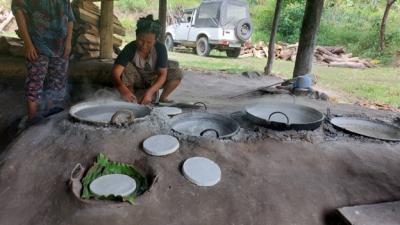
The researchers discovered that Rev was the fith generation descendant of the Chief who founded the village. The picture of the Naga man hanging on the wall is his grandfather (second generation). Rev added, "When I talk about it, I can imagine it as if it were happening right before my eyes. On that day, my grandfather, my father and my uncle (my father's younger brother) were beheaded, along with six others. I won't be able to recount all the details, but they are written in detail in this manuscript. Please read it."
Rev handed me a two-page manuscript written on A4 size paper. It read, "(The murder of innocent people in the aftermath of the attack on the Assam Rifles Post in Thuda (Phor) and the shooting down of transport aircraft Dakota by Naga resistance soldiers)" and "The Shooting Down of the Dakota by Naga Underground Forces." The manuscript described the events that took place on September 6, 1960. Around 10 o'clock in the afternoon, the Punjab Regiment of the Indian Army entered the village and surrounded it in three waves, preventing anyone from escaping. With a terrifying voice, they called the entire village to come out. The men were subjected to beatings and torture in various ways, while the women and children were forced to witness the ordeal throughout the day. At around 4:00 p.m., the women and children were driven into the forest, and the heads of the families, who had already endured beatings and torture all day, were beheaded and their houses were burned.
After reading the manuscript given by Rev, I did not want him to dwell on any more unpleasant memories, so I changed the topic.
Following that, GB introduced me to a grandfather (Apfüse in the Chakhesang language) who had been among those tortured but managed to escape death. It was from him that I learned about the first destruction of the village. Upon being introduced to Apfüse, he began to speak,
"We have experienced a nightmare that is difficult for humans to bear. I don't think anyone in this world has ever suffered as much as our villagers."
There was a moment of silence as Apfüse's face displayed haunted expressions, seemingly saddened by something. Yet, there were also glimpses of compassion on his forgiving and generous face. He then requested that I carefully record his words and write a book about them.
Apfüse continued, "On September 6, 1960, around 10 o'clock in the morning, the villagers were brutally murdered by Indian soldiers. The Indian soldiers entered the village and, with a terrifying voice, called the entire village out to gather. At that time, there were just over 10 houses in the village, close to each other, so the villagers had no chance to run away or hide. The whole village gathered around the Chief's house. The women and children were asked to stand on one side, while the men (heads of households and adult men) were asked to stand on the other side. The soldiers made the men pull their ears and jump like frogs, forcing them to scream like monkeys. The victims were tied up and left to dry under the sun. While torturing them in that manner, the Indian soldiers continuously hit and beat them with their guns and sticks. At that time, my father (adoptive father) was the oldest in the village, so he couldn't run at all. The soldiers trampled upon my father with their boots, delivering kicks and strikes with their guns. As a result, his thigh turned black, and his eyes swelled up to the point where he couldn't even see. The women and children were forced to witness this horrific act of torture. Overwhelmed with sorrow for my father, I shouted, 'Instead of enduring such brutal beatings, why not follow your friends if you cannot escape?' I'm not sure how old I was at the time. I think I was around 14 years old. A soldier dragged me away for saying that, and I, too, was beaten like the other adults. I was punished alongside the village uncles on behalf of my father. The individuals who were tortured suffered severe injuries, including broken backs, feet, and hands. Their ribs were fractured, and some of the victims were forcefully dragged away for further punishment. The women watched, screamed, and cried as they had to witness their men and elder sons being tortured. After a whole day of torture, at around 4 o'clock in the evening, the soldiers drove all the women and children into the forest. I was tied up and kept somewhere separate. My father and the others were kept in the Chief's house. While I was held separately, a soldier who appeared to be Nepali made signs with his hand towards me. I wasn't sure if he was signaling me to run away. However, due to the relentless beatings I had endured, my legs were immobile and unresponsive. That's why I rolled my body down the hill. Just as I was rolling down, I heard a series of gunshots. At that time, I thought that my father had already been shot. But my father and the others who were kept in the Chief's house were beheaded. I didn't witness it with my own eyes, but it was said that when the first person was beheaded, an uncle sitting by the door ran away saying, 'We have done nothing wrong, and we can't bear to be beheaded for no reason.' The sound of the gunshot I had heard turned out to be the execution of the uncle who had managed to flee. Fortunately, the bullet only grazed his little finger. From what he recounted, the captors forced their victims to line up in rows like sheep before proceeding to behead them one by one. When a soldier brought a big knife (Dao in Nagamese) to cut off his head, the Chief shouted, 'It is a man's pride to sacrifice for his birthright and shall never surrender nor compromise. I am ready to sacrifice my life for the future generation of the Nagas.' Before he could finish yelling, the soldier cut off the head of the first victim. At that moment, he ran away. On that day, nine people, including the Chief, were beheaded. I wonder if God had spared him just so he could talk about these events. A month later, he died from psychological trauma and injuries inflicted during the torture. He left behind a wife and five children. His wife is still alive. I don't know how my elder brother managed to escape, but when the villagers heard the sound of groaning and moaning at the foot of the village, they found him with knife wounds on both shoulders. It wasn't long before he died at the hands of the villagers."
"To continue my story, I rolled down the hill and tried to find where the women and children had gone. I couldn't hear any sound. With only one shirt remaining on my body, I took it off and laid it out on the ground. I wasn't sure of my exact location. It was then that I found myself surrounded by a group of leopards. However, having encountered far more terrifying experiences, I no longer felt any fear towards them. I stayed in that spot and eventually fell asleep. The next day, I followed the sounds of children crying and found the mothers and children in a state of severe hunger. The mothers, fearing that the soldiers would track them down due to the sound of their crying children, temporarily left their children and went to the creek to wet their turbans with water. Upon returning, they squeezed the water into their children's palms and let them drink.
Some mothers suggested going back home, while others were concerned that the children would be killed. Finally, following the advice of the elder women who believed that the soldiers could return to the village and that their children would be killed, thus erasing their generation, they decided to go to Khrowemi village. However, some of them were too weak from starvation to walk the entire way. When they reached the village, they were graciously provided with food. From there, they continued their journey to the village of Losami, where the Naga soldiers had set up tarpaulin tents and generously offered them rice. The Indian Government offered assistance due to the village's destruction, but the Naga soldiers firmly refused their help.
The Naga soldiers sent us to the Sathi refugee camp on the Burmese side, stating that it was not safe for us to stay there for a long time. In the refugee camp, sixteen people had to share 1 kg of rice. As farmers, we eat a lot of rice. When we were in the village, only about two men would consume 1 kg of rice. Life was difficult in the refugee camp. We would be scared every time we heard the sound of airplanes. The elderly mothers reported to the relevant authorities that our children would starve to death if we continued living there, and they requested multiple times to return to their village. The Naga armed forces did not immediately allow us to return for our safety. So we lived in that camp for over a year. Later, the Pochury Hoho (one of the customary governing body of Nagaland, which each tribe has) issued a statement saying that if no one returned to the village, other tribes would occupy it, and it was time to go back and rebuild the village.
Rebuilding Machi: From a Harmonious Haven to Growth and Environmental Challenges
Towards the end of 1962 and before the new year of 1963, we all returned to the village where our fathers had died. We were led by our mothers. We spent the 1963 New Year in the village. Life was extremely difficult. This village was like a an orphan village. However, no matter how challenging it was, we built houses with whatever means we had. Historically, our village was first founded by our grandfathers. This second time, it was rebuilt by our mothers. Pochury people from neighboring areas also came to assist our village, which felt like an orphaned village. Despite the feelings of loss and sadness, the presence of people who extended help provided us with a sense of strength and support. At that time, the fith generation of the elder who founded the village for the first time was only around 9 years old, so there was no one to be the head of the village, and the chieftaincy system was no longer practiced."
As Apfüse narrated the village's history, it deeply moved me, filling me with vivid imagination and a mix of awe and reverence. I then attentively listened to a 59-year-old man who had relocated to the village in 1963.
"My parents moved to this village from Kiphire in 1963. I was born here in 1964. My parents told me that the underground revolutionaries (referring to the Naga armed forces) urged them to come and help this village. There were no more fathers here at that time. They said, 'We must go and live in that village,' and so we did. By the time I came of age, there were already around 35 houses in this village."
A 83-year-old migrant from Zhipu said, "This village is a great place to live. The weather is pleasant, and the crop yields are good. I served in the Naga armed forces for over 30 years, so I have been to many regions. Among them, I liked this village the most, so I settled here at the end of 1970 when I left the armed forces. At that time, I think there were around 60 houses."
According to the 49-year-old village Head GB, since 1963, more and more people had been moving to this village. The village had plenty of land, and farms expanded. As a result, the village elders stopped accepting people from other places in 1984. Currently, there are over 130 houses in total.
According to Rev, prior to 1960, Machi village was a family-oriented community filled with love, where people wholeheartedly followed the leadership of the chief. Apfüse remarked, "Before 1960, this village was brimming with love. It was a delightful social haven. When we were young, there was no religious divide. Everyone would drink rice wine (Zutho in local language). During that time, there were no religious teachings, yet people exhibited exceptional manners and conscientiousness. At that time only five villagers had converted to Christianity (the village chief was the first to convert. Other people were animists). When a family faced difficulties, be it illness or other circumstances, the entire village would come together to offer assistance. They would collectively clean the houses of orphaned children, launder their clothes, and ensure they had enough food. Consequently, the village resembled one large family." A grandfather shared, "In the past, people were less driven by greed. When the chief made decisions regarding farming locations and schedules, everyone would follow suit. The chief would determine when to plant rice and establish designated days for harvesting, and everyone would work together harmoniously."
After the village was reestablished in 1962, the population gradually increased as people migrated from other areas, and those who moved in were registered with Machi village citizenship (at that time they use citizenship instead of Aadhaar Card, which is like a national identity card). All Machi citizens were granted the right to cultivate the hills and establish new farmland. The original landowners also had to sell some of their land to rebuild their families. According to Apfüse's account, upon returning from the refugee camp after losing his parents and siblings, he had to exchange a plot of ancestral land for a pig from his aunt in another village as part of his wedding arrangement.
By 1970, the number of households in the village had reached approximately 70. Despite the positive aspects of population growth, such as new school buildings and collective efforts for community affairs, the village head GB expressed concerns about the environmental impact. The growing population's shared utilization of the village's natural resources had strained the environment's limited capacity, necessitating careful consideration.
According to a 59-year-old respondent and Reverend, starting from 1970, timber companies began purchasing timber from the village up to Akash Bridge, located roughly 20 kilometers outside the village. Subsequently, the number of entrepreneurs buying timber gradually increased, leading to an escalation in timber production from either the village's land or private properties. This resulted in the depletion of large trees within the village's land. Consequently, the village elders recognized the need to preserve the forests for future generations. In 1981 and 1982, they implemented measures to regulate the sale of wood from the village's land, imposing a specific limit of one carload per household per year. After 1982, timber production from village-owned land was completely prohibited by the village GB and council. If newly married couples required wood for building their houses, they could only obtain it with the permission of the village head. However, the use of timber from private properties was left to the discretion of the individual.
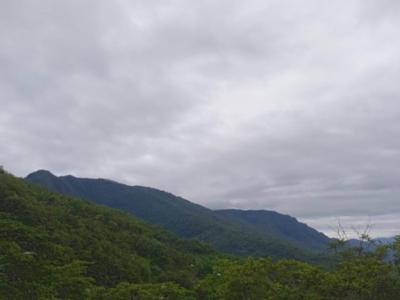
The Vanishing Forest: Climate Change and Conservation Efforts
Village residents perceive that the disappearance of large trees has led to significantly hotter weather. A 78-year-old grandfather remarked, "We moved to this village in 1966 when I came here as a teacher. At that time, the forest was still dense. We could predict a good harvest for the year based on the condition of the plants and flowers. However, these days, even if the plants and flowers appear healthy, unpredictable weather patterns, insects, and other factors affecting the fruiting stage can greatly impact the yield, contradicting our expectations. Consequently, accurate predictions are no longer possible. In the old days, the elders had a method of predicting the weather by observing the moon. If the moon appeared yellow, it was believed that the weather might not be favorable for the year. Conversely, if the moonlight appeared white, it was predicted to be good weather. They could forecast the amount of rain by observing the intensity of sunlight. Nowadays, predictions rarely prove accurate. The weather has become extremely fickle; regular patterns can no longer be observed. People no longer show respect for forests and trees, and consequently, they have become disloyal to one another," he said.
The 83-year-old grandfather said, "I moved to this village in 1970. At that time, there were still many large trees." He pointed towards the mountains north of the village, in the direction of Myanmar, and said, "In the past, I could tell if it was going to rain by looking at that mountain. If it appeared dark, I knew the rain would soon come to us as well. But now, even if it's dark from that side, the rain doesn't come anymore. I wonder if it's because there are no more trees. In the past, my grandparents could predict the weather for the year from as early as January and February by observing the wind speed. Their predictions were consistently accurate. Back then, the wind started to blow in January and grew stronger in April. The rain came in May. Now, the wind doesn't blow, and the rain falls abnormally and untimely."
Apuse further explained that in the past, even during rainfall, they could wear raincoats and continue working. They would work all day, every day, wearing Pekala (a hooded rainwear made of woven fronds). Nowadays, the sun is scorching, and the intense heat makes it unbearable to expose one's back to the sun, and even walking on the ground becomes difficult due to the excessive heat. And if it rains, it suddenly turns very cold, like winter, making work difficult. Moreover, when entering the deep forest, the ground is dry instead of moist due to the lack of large trees. During rainfall, water levels rise rapidly, but all the water disappears once the rain stops. Natural springs have vanished.
In the village, it is perceived that climate change is occurring due to the destruction of forests, and both the elders and youth of the village are taking this issue seriously. Cutting down forest trees has been prohibited since 1982, and the village forest and wildlife conservation area have been designated and maintained through a self-sustaining system for approximately 20 years. Cutting trees and hunting wild animals for any reason within the forest reserve is strictly forbidden. Strict rules have been established to ensure compliance with these prohibitions, and the village council and Goan-Bura group have delegated the responsibility of environmental preservation to the youth of the village. The village youth are well accountable for conserving the forest and conduct regular patrols of the conservation area for unexpected inspections. During these inspections, individuals found engaged in hunting can face fines of up to 5,000 rupees, regardless of whether they have caught any prey or not. If a prey animal is found, the fines range from 5,000 to 20,000 rupees, depending on the species. Additionally, responsible citizens who report violations are eligible for an anonymous reward system implemented by the youth. If the perpetrators do not accept the decisions of the youth and argue, they are handed over to the village council, and the punishment is doubled.
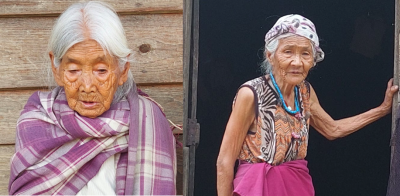
Healing traumas and courageous mothers
Machi village was founded by the ancestors of the indigenous people themselves, and the mothers bravely rebuilt the village for the second time, even in the absence of male leaders due to brutal killings by the Indian army. The deep bond and attachment of the indigenous people to their land is evident in the history of Machi village. The support received from neighboring tribes and other regions, who relocated to the village when it was without male heads, reflects the loving traditions and mutual support within the Pochury tribes. This demonstrates their willingness to stand united and their profound sense of patriotism. It was also observed that when outsiders entered the community, after the village was destroyed and then reconstructed, the natural resources of the village were shared. Considering the surrounding environment, it becomes apparent that the population growth resulting from migration to the village and subsequent resource sharing have had adverse impacts on the local environment. Now, the locals are aware of the damage and are restoring the forests in their own way, emphasizing the profound care and concern the indigenous people have for the environment.
I couldn't help but feel that the hardships endured by Machi's ancestors were too much for any human being to bear. I wanted to understand how one can heal from such traumas and resentments caused by such a bitter and painful experience. However, both Apfüse and the Rev gave me the same answer, "Judgment and forgiveness do not come from human beings but from above (God). If human beings harbor hatred and seek revenge, the world will never find peace. But our young people must learn the history." Hearing their response, I could feel my heart racing and warm tears streaming down my face. I couldn't express enough respect for them.
When I heard the story of how the village was rebuilt under the leadership of the mothers, it left me deep in thought. I wondered about the immense courage and strength displayed by these mothers as they reconstructed a village filled with happiness and cherished memories. It was a place where couples and lovers resided, a community known for mutual support and the sacrifices made by beloved husbands and children, as well as the fallen fathers.
I couldn't help but marvel at the bravery of these mothers, who rebuilt the village despite the haunting memories of the past. Today, thanks to the visionary mothers, Machi village stands as a historic village of the Pochury people. Pochury Black Day is now celebrated every September 6th in Machi village.
I would like to extend my special thanks to the Head GB and all the respondents who answered all the questions I had. It is thanks to their cooperation that such valuable information has come to light, and the entire study process went smoothly. This trip has become an unforgettable milestone in my life.
Written by Lu Chi
DIIS Experts


